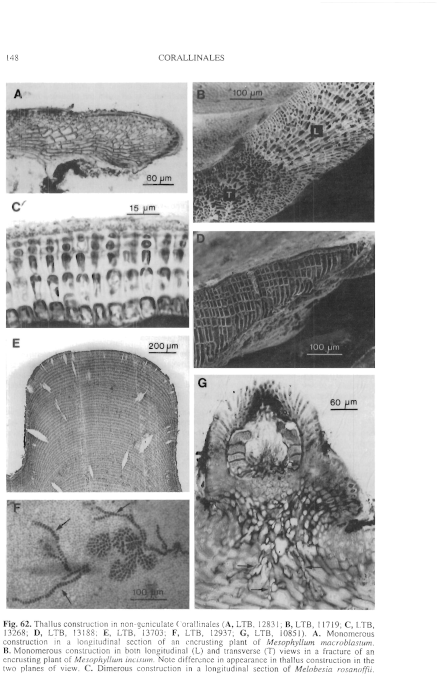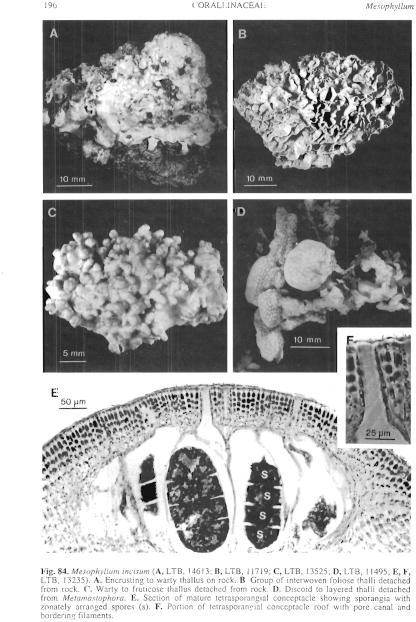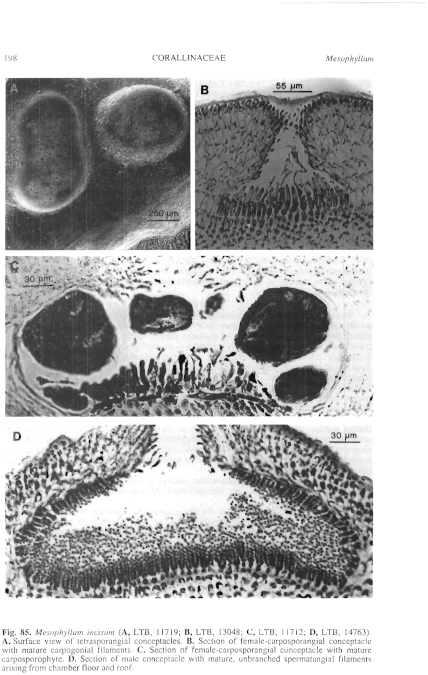|
|
|
|
|
|||||||||||
|
Electronic Flora of South Australia Species Fact Sheet
Phylum Rhodophyta – Class Florideophyceae – Order Corallinales – Family Corallinaceae – Subfamily Melobesioideae
Selected citations: Woelkerling & Harvey 1992: 381, figs 1–36; 1993: 587, figs 12–16.
Synonyms
Lithothamnion patena f. incisa Foslie 1906: 8. Woelkerling 1993: 123.
Lithothamnion incisum (Foslie) Foslie 1907b: 12.
Thallus normally pinkish, encrusting to warty, lumpy, discoid, layered or foliose, mostly 2–200 mm across and 0.04–12 mm thick or tall, epigenous and partially to completely affixed by cell adhesion; protuberant branches simple, mostly 0.8–12 mm in diameter and 0.5–12 mm long; lamellate branches applanate to ascending or upright, often layered, mostly 3–23 mm across and 2–7 mm long. Structure pseudoparenchymatous, organisation dorsiventral in crustose portions and lamellate branches but radial in protuberant branches; construction monomerous, consisting of a single system of branched, laterally cohering, filaments that collectively contribute to a ventrally or centrally situated core and a peripheral region where portions of core filaments or their derivatives curve outwards towards the thallus surface; each filament composed of cells 5–15 µm in diameter and 7–35 µm long; epithallial cells 5–12 µm in diameter and 5–10 µm long, terminating most filaments at the thallus surface, with distal walls rounded or flattened but not flared; cell elongation occurring mainly within actively dividing subepithallial initials that are usually as long as or longer than their immediate inward derivatives; cells of adjacent filaments joined by cell-fusions; trichocytes occasional, solitary or in small fields; secondary pit-connections and haustoria unknown.
Reproduction: Vegetative reproduction unknown. Gametangia and carposporophytes produced in uniporate conceptacles; tetrasporangia and bisporangia produced in multiporate conceptacles.
Gametangial thalli monoecious or dioecious; carpogonia and spermatangia produced in separate conceptacles. Carpogonia terminating 2- or 3-celled filaments arising from the female conceptacle chamber floor. Mature female-carposporangial conceptacle roofs protruding above surrounding thallus surface, 75–185 µm thick, composed of 6–15 layers of cells above the chamber, conceptacle chambers 270–450 µm in diameter and 75–240 µm high. Carposporophytes lacking a conspicuous central fusion cell and apparently consisting of an irregularly shaped fusion cell that may look discontinuous in section and several-celled gonimoblast filaments bearing terminal carposporangia 25–155 µm in diameter. Spermatangial filaments unbranched, arising from the floor, walls and roof of male conceptacle chambers; mature male conceptacle roofs protruding above surrounding thallus surface, 45–90 µm thick, composed of 5–9 layers of cells above the chamber; conceptacle chambers 190–330 (–420) µm in diameter and 50–120 µm high.
Tetrasporangial/bisporangial conceptacle roofs protruding above surrounding surface, not differentiated into a peripheral rim and a central sunken pore-plate, 4–7 cells thick above the chamber; pore canals lined by cells (especially near the base of the canal) that are narrower and more elongate than adjacent roof cells; conceptacle chambers 340–655 µm in diameter and 130–265 µm high; tetrasporangia scattered across the conceptacle chamber floor; each mature sporangium 55–130 µm in diameter and 130–220 µm long, containing zonately arranged tetraspores and possessing an apical plug that blocks a roof pore prior to spore release; bisporangia occasional, 62–130 µm in diameter and 121–205 µm long.
Type from Bay of Islands, New Zealand; lectotype in TRH (Setchell No. 6354; includes two slides numbered 1175); designated by Woelkerling & Harvey (1992, p. 383); depicted in Woelkerling & Harvey (1992, p. 383, fig. 1) and Woelkerling & Harvey (1993, p. 618, fig. 12A); additional data provided by Woelkerling (1993, p. 123).
Selected specimens: East Strickland Bay, Rottnest I., W. Aust., reef pools (Woelkerling, 12.ii.1978; LTB, 11046), Garden Island (Five Fathom Bank), W. Aust., 12–15 m deep (Cambridge, 21.ii.1978; LTB, 11495). Lucky Bay, Cape Le Grand National Park, W. Aust., 0–3 m deep (Woelkerling, Platt & Jones, 9.ii.1984; LTB, 14287, 14292, 14296, 14345). Eyre (reef 7 km E of Twilight Cove), W. Aust., 0–3 m deep (Woelkerling, Plan & Jones, 2.ii.1984; LTB, 14080, 14091). Point Fowler (E shore), S. Aust., 2–3 m deep (Plan & Jones, 14.ii.1984; LTB, 14456). Point Westall, S. Aust., 2–3 m deep (Platt & Jones, 16.ii.1984; LTB, 14613). Tiparra Reef, Spencer Gulf, S. Aust., 8 m deep (Shepherd, 13.ii.1975; AD, A49395 = LTB, 13601). Nora Creina, S. Aust., 3–8 m deep (Owen, 3.ix.1971; AD, A39680 = LTB, 13595). Cape Northumberland, S. Aust., reef surface (Womersley, 8.xii.1991; AD, A61544). Port Fairy, Vic., lower eulittoral to upper sublittoral (May, 18.iii.1985; LTB, 14763; Woelkerling, 6.i.1977; LTB 12569 and 4.i.1979; LTB, 11712, 11714, 11719). Anglesea (Ingoldsby Reef), Vic., 9 m deep (Beanland, 5.iii.1983; LTB, 13509, 13523, 13525). Waterloo Bay (Wilsons Prom.), Vic. (Leach, 23.x.1977; LTB, 11446). Eddystone Point, Tas., 0–3 m deep (Platt, 23.ii.1983; LTB, 13193). Bluestone Bay, Freycinet Pen., Tas., 0–2.5 m deep (Plan, 21.ii.1983; LTB, 13048). Coles Bay, Freycinet Pen., Tas., 0–3 m deep (Platt, 21.ii.1983; LTB, 13112). Eaglehawk Neck (Tessellated Pavement), Tas., 1–2 m deep (Platt & Woelkerling, 26.ii.1983; LTB, 13228, 13235). Ninepin Point, D'Entrecasteaux Channel, Tas., 4–6 m deep (Plan & Brown, 18.ii.1983; LTB, 12753). Variety Bay, Bruny I., Tas., 2–4 m deep (Platt, 17.ii.1983; LTB, 13001).
Distribution: New Zealand, Chatham Islands, Snares Islands, Auckland Islands.
In Australia, from East Strickland Bay, Rottnest I., W. Aust., to Waterloo Bay, Wilsons Prom., Vic., and around Tasmania.
Taxonomic notes: Polyporolithon patena var. incisa (Foslie) Chapman & Parkinson 1974: 202.
Additional references involving these binomials are provided by Woelkerling & Harvey 1993. A detailed account of reproductive ontogeny in this species is contained in Woelkerling & Harvey 1992.
Mesophyllum incisum has been found intertidally on reef surfaces and in pools and subtidally to depths of 15 m in southern Australia. It occurs on rock, sponges, and various algae. Gametangial, tetrasporangial and bisporangial thalli may be present in the same population and commonly are collected together on single host thalli.
References:
ADEY, W.H. (1970). A revision of the Foslie crustose coralline herbarium. K. norske Vidensk. Selsk. Skr. 1970 (1), 1–46.
CHAPMAN, V.J. & PARKINSON, P.G. (1974). The marine algae of New Zealand. Part III: Rhodophyceae. Issue 3: Cryptonemiales, pp. 155–278, Plates 51–94. (Cramer: Germany.)
FOSLIE, M. (1906). Algologiske notiser II. K. norske Vidensk. Selsk. Skr. 1906(2), 1–28.
FOSLIE, M. (1907b). Algologiske notiser. IV. K. norske Vidensk. Selsk. Skr. 1907(6), 1–30.
WOELKERLING, W.J. & HARVEY, A. (1992). Mesophyllum incisum (Corallinaceae, Rhodophyta) in southern Australia: implications for generic and specific delimitation in the Melobesioideae. Br. phycol. J. 27, 381–399.
WOELKERLING, W.J. & HARVEY, A. (1993). An account of sourthern Australian species of Mesophyllum (Corallinaceae, Rhodophyta). Aust. Syst. Bot. 6, 571–637.
WOELKERLING, Wm.J. (1993). Type collections of Corallinales (Rhodophyta) in the Foslie Herbarium (TRH). Gunneria 67, 1–289.
The Marine Benthic Flora of Southern Australia Part IIIB complete list of references.
Publication:
Womersley, H.B.S. (28 June, 1996)
The Marine Benthic Flora of Southern Australia
Rhodophyta. Part IIIB. Gracilarialse, Rhodymeniales, Corallinales and Bonnemaisoniales
Reproduced with permission from The Marine Benthic Flora of Southern Australia Part IIIB 1996, by H.B.S. Womersley. Australian Biological Resources Study, Canberra. Copyright Commonwealth of Australia.
Illustrations in Womersley Part IIIA, 1996: FIGS 62B, 84, 85.

Figure 62 enlarge
Fig. 62. Thallus construction in non-geniculate Corallinales (A, LTB, 12831; B, LTB, 11719; C, LTB, 13268; D, LTB, 13188; E, LTB, 13703; F, LTB, 12937; G, LTB, 10851). A. Monomerous construction in a longitudinal section of an encrusting plant of Mesophyllum macroblastum. B. Monomerous construction in both longitudinal (L) and transverse (T) views in a fracture of an encrusting plant of Mesophyllum incisum. Note difference in appearance in thallus construction in the two planes of view. C. Dimerous construction in a longitudinal section of Melobesia rosanoffii.

Figure 84 enlarge
Fig. 84. Mesophyllum incisum (A, LTB, 14613; B, LTB, 11719; C, LTB, 13525; D, LTB, 11495; E, F, LTB, 13235). A. Encrusting to warty thallus on rock. B. Group of interwoven foliose thalli detached from rock. C. Warty to fruticose thallus detached from rock. D. Discoid to layered thalli detached from Metamastophora. E. Section of mature tetrasporangial conceptacle showing sporangia with zonately arranged spores (s). F. Portion of tetrasporangial conceptacle roof with pore canal and bordering filaments.

Figure 85 enlarge
Fig. 85. Mesophyllum incisum (A, LTB, 11719; B, LTB, 13048; C, LTB, 11712; D, LTB, 14763). A. Surface view of tetrasporangial conceptacles. B. Section of female-carposporangial conceptacle with mature carpogonial filaments. C. Section of female-carposporangial conceptacle with mature carposporophyte. D. Section of male conceptacle with mature, unbranched spermatangial filaments arising from chamber floor and roof.

|
Email Contact: State Herbarium of South Australia |

|